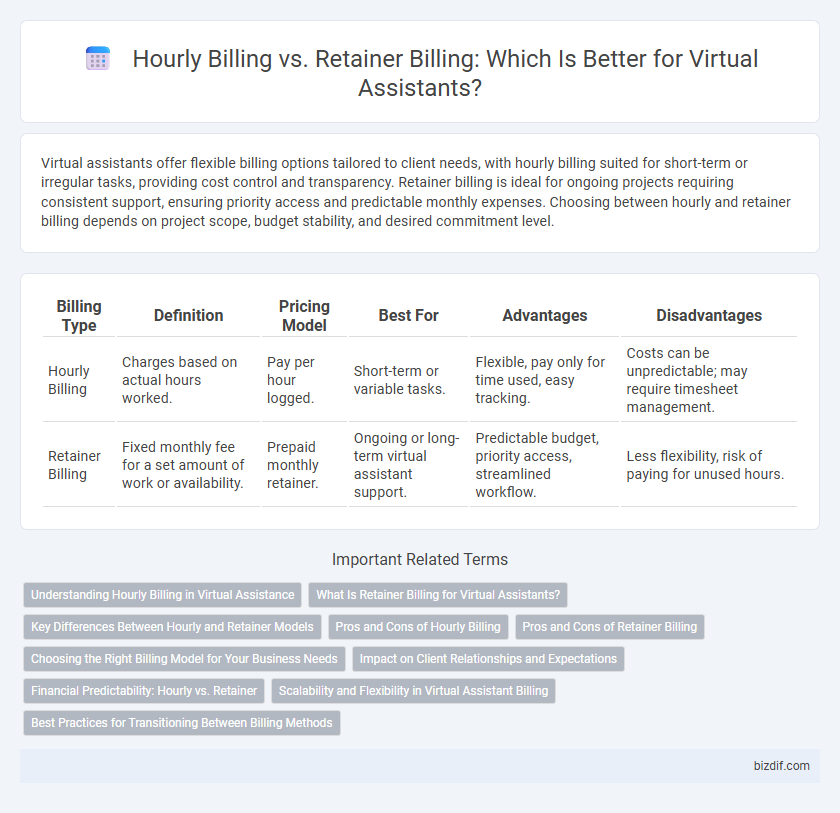Virtual assistants offer flexible billing options tailored to client needs, with hourly billing suited for short-term or irregular tasks, providing cost control and transparency. Retainer billing is ideal for ongoing projects requiring consistent support, ensuring priority access and predictable monthly expenses. Choosing between hourly and retainer billing depends on project scope, budget stability, and desired commitment level.
Table of Comparison
| Billing Type | Definition | Pricing Model | Best For | Advantages | Disadvantages |
|---|---|---|---|---|---|
| Hourly Billing | Charges based on actual hours worked. | Pay per hour logged. | Short-term or variable tasks. | Flexible, pay only for time used, easy tracking. | Costs can be unpredictable; may require timesheet management. |
| Retainer Billing | Fixed monthly fee for a set amount of work or availability. | Prepaid monthly retainer. | Ongoing or long-term virtual assistant support. | Predictable budget, priority access, streamlined workflow. | Less flexibility, risk of paying for unused hours. |
Understanding Hourly Billing in Virtual Assistance
Hourly billing in virtual assistance charges clients based on the exact time spent on tasks, offering transparency and flexibility for both parties. This method allows virtual assistants to track and invoice hours precisely, ensuring clients pay only for services rendered. Hourly rates typically vary depending on experience, specialization, and task complexity, making it suitable for short-term or sporadic projects.
What Is Retainer Billing for Virtual Assistants?
Retainer billing for virtual assistants involves clients paying a fixed monthly fee in exchange for a guaranteed number of service hours or prioritized availability, ensuring consistent support and budget predictability. This billing model fosters long-term relationships, allowing virtual assistants to manage workloads efficiently while clients receive dedicated assistance without fluctuating costs. Retainer agreements often include negotiated terms outlining tasks, response times, and flexibility, optimizing value for both parties.
Key Differences Between Hourly and Retainer Models
Hourly billing charges clients based on the actual time spent on tasks, providing flexibility and transparency but potentially leading to unpredictable costs. Retainer billing involves a fixed recurring fee for a set scope of services or hours, ensuring consistent cash flow and priority access to the virtual assistant. Key differences include cost predictability, client commitment level, and the ability to plan resources efficiently for both parties.
Pros and Cons of Hourly Billing
Hourly billing for virtual assistants offers flexibility and precise tracking of work performed, ensuring clients only pay for actual time spent on tasks. However, this method can lead to unpredictable costs and administrative overhead from constant time tracking and invoicing. It may also discourage efficiency, as longer hours directly increase client charges, potentially reducing motivation to complete tasks swiftly.
Pros and Cons of Retainer Billing
Retainer billing offers consistent revenue and stronger client relationships by guaranteeing payment for a set number of hours or services monthly. This model ensures better resource planning and priority support, but may cause challenges if client demands fluctuate or unused hours accumulate without compensation. Clients benefit from predictable costs, though some may resist upfront commitments or feel restricted by preset service limits.
Choosing the Right Billing Model for Your Business Needs
Hourly billing offers flexibility by charging clients based on actual time spent, ideal for projects with variable scopes or short-term tasks. Retainer billing ensures consistent cash flow and long-term client commitment, suitable for ongoing services requiring predictable resource allocation. Selecting the appropriate billing model depends on factors such as project complexity, client relationship duration, and cash flow management priorities.
Impact on Client Relationships and Expectations
Hourly billing provides transparency and flexibility, allowing clients to pay strictly for the time spent on tasks, which can build trust but may lead to fluctuating costs and uncertain project scope. Retainer billing fosters long-term partnerships by offering consistent access to virtual assistant services and predictable budgeting, enhancing client satisfaction and loyalty. Clear communication about billing structures is essential to align expectations and strengthen client relationships.
Financial Predictability: Hourly vs. Retainer
Hourly billing offers flexibility by charging clients only for actual time spent, but it can lead to unpredictable monthly costs that complicate budget planning. Retainer billing provides financial predictability with a fixed monthly fee, enabling consistent cash flow and easier expense management for both clients and virtual assistants. Choosing retainer billing supports long-term planning and reduces billing disputes, enhancing stability in project management.
Scalability and Flexibility in Virtual Assistant Billing
Hourly billing offers maximum flexibility for virtual assistants, allowing clients to pay only for the work completed, which suits fluctuating workloads and short-term projects. Retainer billing provides scalability by securing a set number of service hours each month, ensuring consistent availability and prioritization for ongoing tasks. This retainer model supports long-term growth and resource planning, making it ideal for clients seeking stability in their virtual assistant support.
Best Practices for Transitioning Between Billing Methods
Transitioning from hourly billing to retainer billing requires clear communication with clients about the benefits of predictable costs and prioritized support. Establishing transparent agreements outlining deliverables, payment schedules, and review periods helps manage expectations effectively. Gradually introducing retainer options alongside hourly services allows clients to adapt while maintaining revenue stability for the virtual assistant.
Hourly billing vs Retainer billing Infographic

 bizdif.com
bizdif.com